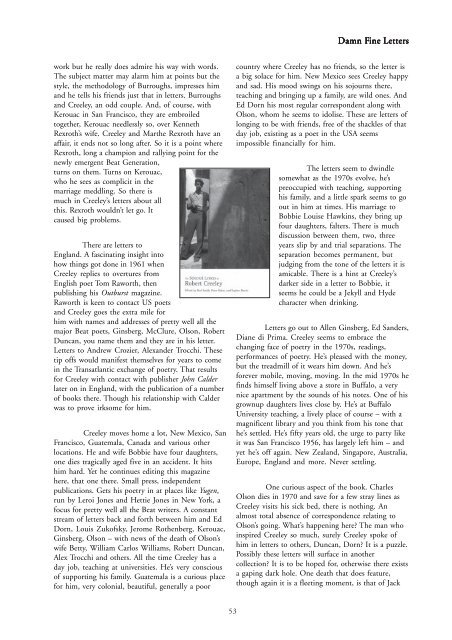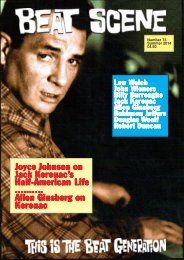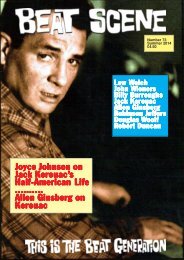You also want an ePaper? Increase the reach of your titles
YUMPU automatically turns print PDFs into web optimized ePapers that Google loves.
Damn Fine Letters<br />
work but he really does admire his way with words.<br />
The subject matter may alarm him at points but the<br />
style, the methodology of Burroughs, impresses him<br />
and he tells his friends just that in letters. Burroughs<br />
and Creeley, an odd couple. And, of course, with<br />
Kerouac in San Francisco, they are embroiled<br />
together, Kerouac needlessly so, over Kenneth<br />
Rexroth’s wife. Creeley and Marthe Rexroth have an<br />
affair, it ends not so long after. So it is a point where<br />
Rexroth, long a champion and rallying point for the<br />
newly emergent Beat Generation,<br />
turns on them. Turns on Kerouac,<br />
who he sees as complicit in the<br />
marriage meddling. So there is<br />
much in Creeley’s letters about all<br />
this. Rexroth wouldn’t let go. It<br />
caused big problems.<br />
There are letters to<br />
England. A fascinating insight into<br />
how things got done in 1961 when<br />
Creeley replies to overtures from<br />
English poet Tom Raworth, then<br />
publishing his Outburst magazine.<br />
Raworth is keen to contact US poets<br />
and Creeley goes the extra mile for<br />
him with names and addresses of pretty well all the<br />
major Beat poets, Ginsberg, McClure, Olson, Robert<br />
Duncan, you name them and they are in his letter.<br />
Letters to Andrew Crozier, Alexander Trocchi. These<br />
tip offs would manifest themselves for years to come<br />
in the Transatlantic exchange of poetry. That results<br />
for Creeley with contact with publisher John Calder<br />
later on in England, with the publication of a number<br />
of books there. Though his relationship with Calder<br />
was to prove irksome for him.<br />
Creeley moves home a lot, New Mexico, San<br />
Francisco, Guatemala, Canada and various other<br />
locations. He and wife Bobbie have four daughters,<br />
one dies tragically aged five in an accident. It hits<br />
him hard. Yet he continues editing this magazine<br />
here, that one there. Small press, independent<br />
publications. Gets his poetry in at places like Yugen,<br />
run by Leroi Jones and Hettie Jones in New York, a<br />
focus for pretty well all the Beat writers. A constant<br />
stream of letters back and forth between him and Ed<br />
Dorn, Louis Zukofsky, Jerome Rothenberg, Kerouac,<br />
Ginsberg, Olson – with news of the death of Olson’s<br />
wife Betty, William Carlos Williams, Robert Duncan,<br />
Alex Trocchi and others. All the time Creeley has a<br />
day job, teaching at universities. He’s very conscious<br />
of supporting his family. Guatemala is a curious place<br />
for him, very colonial, beautiful, generally a poor<br />
country where Creeley has no friends, so the letter is<br />
a big solace for him. New Mexico sees Creeley happy<br />
and sad. His mood swings on his sojourns there,<br />
teaching and bringing up a family, are wild ones. And<br />
Ed Dorn his most regular correspondent along with<br />
Olson, whom he seems to idolise. These are letters of<br />
longing to be with friends, free of the shackles of that<br />
day job, existing as a poet in the USA seems<br />
impossible financially for him.<br />
The letters seem to dwindle<br />
somewhat as the 1970s evolve, he’s<br />
preoccupied with teaching, supporting<br />
his family, and a little spark seems to go<br />
out in him at times. His marriage to<br />
Bobbie Louise Hawkins, they bring up<br />
four daughters, falters. There is much<br />
discussion between them, two, three<br />
years slip by and trial separations. The<br />
separation becomes permanent, but<br />
judging from the tone of the letters it is<br />
amicable. There is a hint at Creeley’s<br />
darker side in a letter to Bobbie, it<br />
seems he could be a Jekyll and Hyde<br />
character when drinking.<br />
Letters go out to Allen Ginsberg, Ed Sanders,<br />
Diane di Prima. Creeley seems to embrace the<br />
changing face of poetry in the 1970s, readings,<br />
performances of poetry. He’s pleased with the money,<br />
but the treadmill of it wears him down. And he’s<br />
forever mobile, moving, moving. In the mid 1970s he<br />
finds himself living above a store in Buffalo, a very<br />
nice apartment by the sounds of his notes. One of his<br />
grownup daughters lives close by. He’s at Buffalo<br />
University teaching, a lively place of course – with a<br />
magnificent library and you think from his tone that<br />
he’s settled. He’s fifty years old, the urge to party like<br />
it was San Francisco 1956, has largely left him – and<br />
yet he’s off again. New Zealand, Singapore, Australia,<br />
Europe, England and more. Never settling.<br />
One curious aspect of the book. Charles<br />
Olson dies in 1970 and save for a few stray lines as<br />
Creeley visits his sick bed, there is nothing. An<br />
almost total absence of correspondence relating to<br />
Olson’s going. What’s happening here? The man who<br />
inspired Creeley so much, surely Creeley spoke of<br />
him in letters to others, Duncan, Dorn? It is a puzzle.<br />
Possibly these letters will surface in another<br />
collection? It is to be hoped for, otherwise there exists<br />
a gaping dark hole. One death that does feature,<br />
though again it is a fleeting moment, is that of Jack<br />
53





